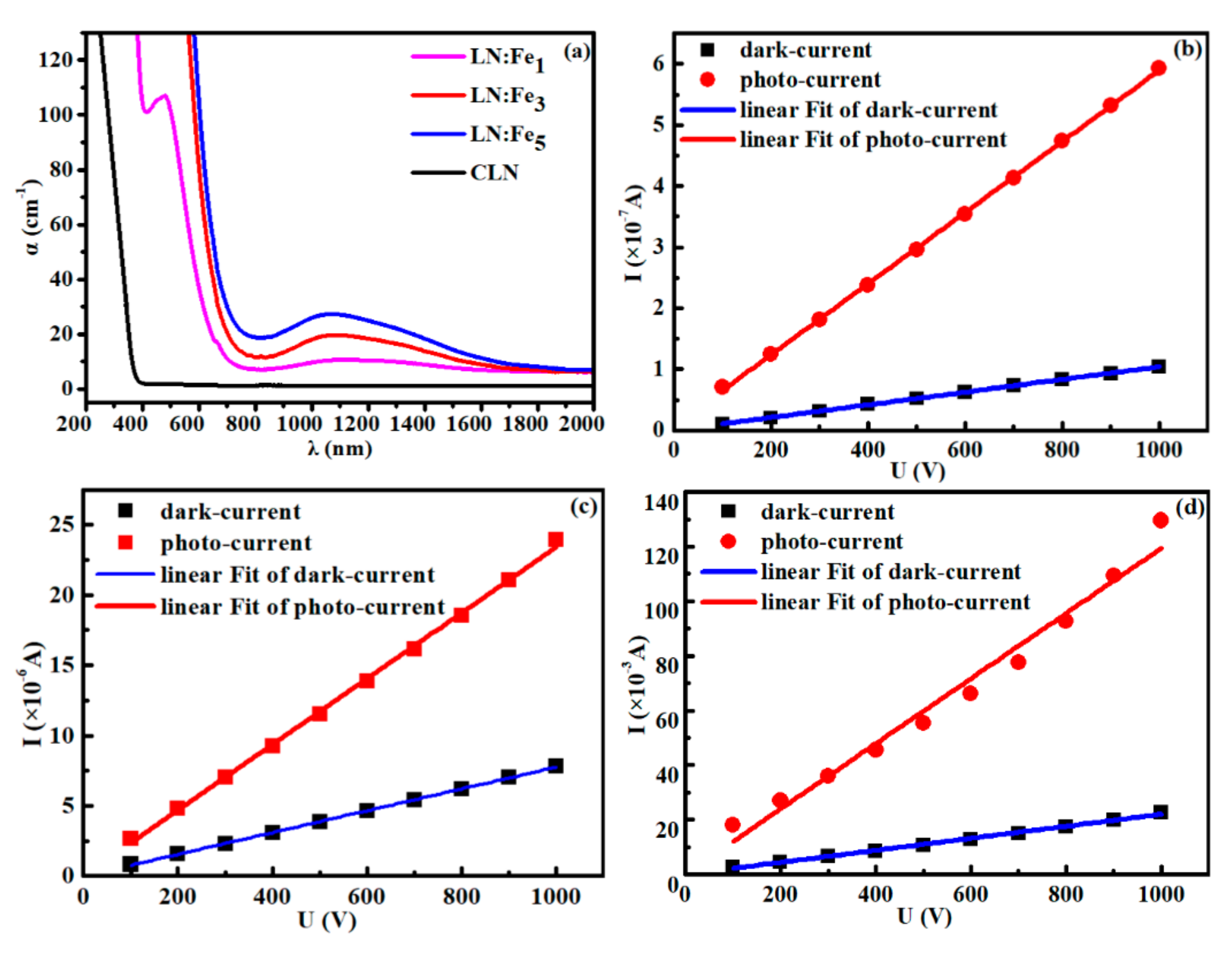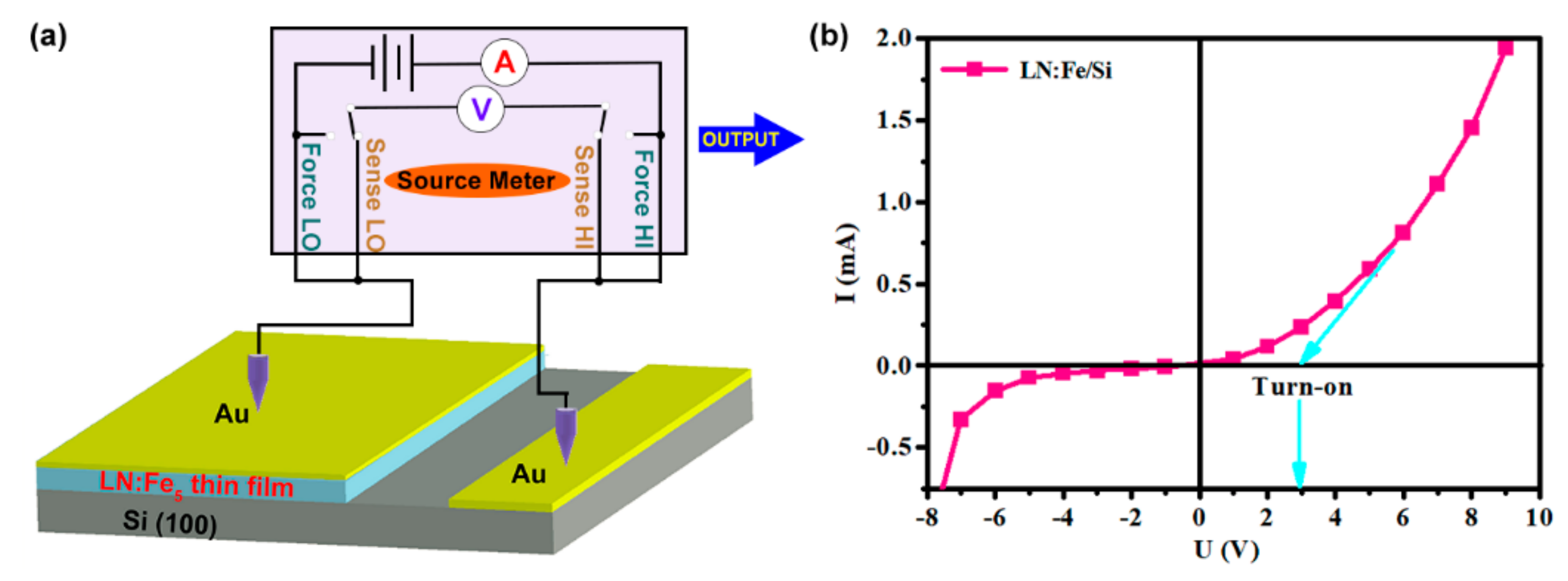Fabrication and Characteristics of Heavily Fe-Doped LiNbO3/Si Heterojunction
Abstract
:1. Introduction
2. Experimental Details
2.1. Samples Preparation
2.2. Measurements
3. Results and Discussion
3.1. Absorption Spectrum and Conductivity of LN:Fe Crystals
3.2. LN:Fe5/Si p-n Junction and Its Rectification Characteristics
3.3. Energy Band Diagram of the LN:Fe5/Si p-n Junction
4. Conclusions
Author Contributions
Funding
Conflicts of Interest
References
- Chen, H.; He, Z.; Wang, W. Design of a multi-mode interference crossing structure for three periodic dielectric waveguides. Prog. Electromagn. Res. Lett. 2018, 75, 47–52. [Google Scholar] [CrossRef]
- Yariv, A. Introduction to Optical Electronics; Holt, Rinehart and Winston: Boston, MA, USA, 1971. [Google Scholar]
- Berciano, M.; Marcaud, G.; Damas, P.; Roux, X.L.; Crozat, P.; Ramos, C.A.; Galacho, D.P.; Benedikovic, D.; Marris-Morini, D.; Cassan, E.; et al. Fast linear electro-optic effect in a centrosymmetric semiconductor. Commun. Phys. 2018, 1, 2399–3650. [Google Scholar] [CrossRef]
- Bonfadini, S.; Ciciulla, F.; Criante, L.; Zaltron, A.; Simoni, F.; Reshetnyak, V.; Lucchetti, L. Optofluidic platform using liquid crystals in lithium niobate microchannel. Sci. Rep. 2019, 9, 1062. [Google Scholar] [CrossRef]
- Cai, L.; Gorbach, A.V.; Wang, Y.; Hu, H.; Ding, W. Highly efficient broadband second harmonic generation mediated by mode hybridization and nonlinearity patterning in compact fiber-integrated lithium niobate nano-waveguides. Sci. Rep. 2018, 8, 12478. [Google Scholar] [CrossRef]
- Li, W.; Ji, L.J. Perovskite ferroelectrics go metal free. Science 2018, 361, 132. [Google Scholar] [CrossRef] [PubMed]
- Von Hoegen, A.; Mankowsky, R.; Fechner, M.; Forst, M.; Cavalleri, A. Probing the interatomic potential of solids with strong-field nonlinear phononics. Nature 2018, 555, 79–82. [Google Scholar] [CrossRef]
- Jin, Y.; Zhang, N.; Zhang, B. Fabrication of p-type ZnO:N films by oxidizing Zn3N2 films in oxygen plasma at low temperature. Materials 2017, 10, 236. [Google Scholar] [CrossRef] [PubMed]
- Kong, Y.; Bo, F.; Wang, W.; Zheng, D.; Liu, H.; Zhang, G.; Rupp, R.; Xu, J. Recent progress in lithium niobate: Optical damage, defect simulation, and on-chip devices. Adv. Mate. 2019, 1806452. [Google Scholar] [CrossRef]
- Falk, M.; Japs, J.; Woike, T.; Buse, K. Charge transport in highly iron-doped oxidized lithium niobate single crystals. Appl. Phys. B 2007, 87, 119–122. [Google Scholar] [CrossRef]
- Luedtke, F.; Villarroel, J.; García-Cabañes, A.; Buse, K.; Carrascosa, M. Correlation between photorefractive index changes and optical damage thresholds in z-cut proton-exchanged-LiNbO3 waveguides. Opt. Express 2009, 17, 658–665. [Google Scholar] [CrossRef]
- Göring, R.; Zhan, Y.; Steinberg, S. Photoconductivity and photovoltaic behavior of LiNbO3 and LiNbO3 waveguides at high optical intensities. Appl. Phys. A 1992, 55, 97–100. [Google Scholar] [CrossRef]
- Kovács, L.; Ruschhaupt, G.; Polgár, K.; Corradi, G.; Wöhlecke, M. Composition dependence of the ultraviolet absorption edge in lithium niobate. Appl. Phys. Lett. 1997, 70, 2801. [Google Scholar] [CrossRef]
- Schlarb, U.; Betzler, K. Refractive indices of lithium niobate as a function of temperature, wavelength, and composition: A generalized fit. Phys. Rev. B 1993, 48, 15613–15620. [Google Scholar] [CrossRef] [PubMed]
- Merschjann, C.; Berben, D.; Imlau, M.; Wöhlecke, M. Evidence for two-path recombination of photoinduced small polarons in reduced LiNbO3. Phys. Rev. Lett. 2006, 96, 186404. [Google Scholar] [CrossRef] [PubMed]
- Sasamoto, S.; Hirohashi, J.; Ashihara, S. Polaron dynamics in lithium niobate upon femtosecond pulse irradiation: Influence of magnesium doping and stoichiometry control. J. Appl. Phys. 2009, 105, 083102. [Google Scholar] [CrossRef]
- Gonzalo, J.; Chaos, J.A.; Suárez-García, A.; Afonso, C.N.; Pruneri, V. Enhanced second-order nonlinear optical response of LiNbO3 films upon Er doping. Appl. Phys. Lett. 2002, 81, 2532–2534. [Google Scholar] [CrossRef]
- Kinoshita, T.; Nagashima, T.; Obata, T.; Takashima, S.; Yamamoto, R.; Togashi, R.; Kumagai, Y.; Schlesser, R.; Collazo, R.; Koukitu, A.; et al. Fabrication of vertical Schottky barrier diodes on n-type freestanding AlN substrates grown by hydride vapor phase epitaxy. Appl. Phys. Express 2015, 8, 061003. [Google Scholar] [CrossRef]
- Novikov, A. Experimental measurement of work function in doped silicon surfaces. Solid State Electron 2010, 54, 8–13. [Google Scholar] [CrossRef]
- Streetman, B.G.; Banerjee, S. Solid State Electronic Devices; Prentice Hall: Englewood Cliffs, NJ, USA, 1995. [Google Scholar]
- Yang, W.C.; Rodriguez, B.J.; Gruverman, A.; Nemanich, R.J. Polarization-dependent electron affinity of LiNbO3 surfaces. Appl. Phys. Lett. 2004, 85, 2316–2318. [Google Scholar] [CrossRef]
- Hao, L.; Li, Y.; Zhu, J.; Wu, Z.; Deng, J.; Liu, X.; Zhang, W. Fabrication and electrical properties of LiNbO3/ZnO/n-Si heterojunction. AIP Adv. 2013, 3, 042106. [Google Scholar] [CrossRef]
- Guo, S.M.; Zhao, Y.G.; Xiong, C.M.; Lang, P.L. Rectifying IV characteristic of LiNbO3/Nb-doped SrTiO3 heterojunction. Appl. Phys. Lett. 2006, 89, 223506. [Google Scholar] [CrossRef]




| Crystal | σd (Ω−1 cm−1) | σph (Ω−1 cm−1) |
|---|---|---|
| LN:Fe1 | 1.56 × 10−10 | 7.70 × 10−10 |
| LN:Fe3 | 1.16 × 10−8 | 2.35 × 10−8 |
| LN:Fe5 | 3.30 × 10−8 | 1.46 × 10−7 |
| CLN | 5.0 × 10−15 [11] | 10−12 [12] |
© 2019 by the authors. Licensee MDPI, Basel, Switzerland. This article is an open access article distributed under the terms and conditions of the Creative Commons Attribution (CC BY) license (http://creativecommons.org/licenses/by/4.0/).
Share and Cite
Li, W.; Cui, J.; Zheng, D.; Wang, W.; Wang, S.; Song, S.; Liu, H.; Kong, Y.; Xu, J. Fabrication and Characteristics of Heavily Fe-Doped LiNbO3/Si Heterojunction. Materials 2019, 12, 2659. https://doi.org/10.3390/ma12172659
Li W, Cui J, Zheng D, Wang W, Wang S, Song S, Liu H, Kong Y, Xu J. Fabrication and Characteristics of Heavily Fe-Doped LiNbO3/Si Heterojunction. Materials. 2019; 12(17):2659. https://doi.org/10.3390/ma12172659
Chicago/Turabian StyleLi, Wencan, Jiao Cui, Dahuai Zheng, Weiwei Wang, Shuolin Wang, Shaoqing Song, Hongde Liu, Yongfa Kong, and Jingjun Xu. 2019. "Fabrication and Characteristics of Heavily Fe-Doped LiNbO3/Si Heterojunction" Materials 12, no. 17: 2659. https://doi.org/10.3390/ma12172659





